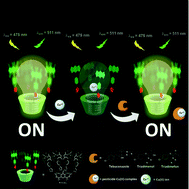A highly sensitive “ON–OFF–ON” dual optical sensor for the detection of Cu(ii) ion and triazole pesticides based on novel BODIPY-substituted cavitand†
Abstract
The synthesis with full structural characterization including elemental analysis and 1H, 13C, 11B and 19F NMR, FT-IR and MALDI-TOF spectral data, along with the florescence sensing behavior of a new resorcin[4]arene cavitand 3 bearing multiple BODIPY sites achieved by the Cu-catalyzed azide–alkyne cycloaddition (CuAAC) is being reported. The spatial orientation of multiple BODIPY-1,2,3-triazole arms based on the macrocyclic rigid core is of great interest since the resulting structure has been utilized as a fluorescent chemosensor for numerous metal cations. In particular, a remarkable decrease in the fluorescence emission towards Cu(II) ions, i.e., “turn-off” response, has been obtained giving rise to an optical sensor for the detection of triazole fungicides, namely tebuconazole, triadimenol, triadimefon, i.e. “turn-on” response. Such a molecular system, hence, can be feasibly applied as a dual optical sensor, i.e. “a turn-on–off–on” system, for dangerous contaminants such as heavy metals and pesticides.



 Please wait while we load your content...
Please wait while we load your content...